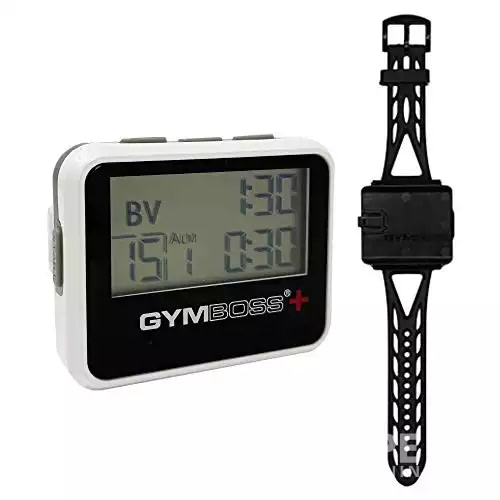Circuit training is an excellent way to boost your fitness levels quickly and efficiently. This type of workout combines strength training and cardio exercises, providing a full-body workout in a short amount of time.
By rotating through different exercises with minimal rest, you can improve both muscular strength and endurance.
Starting with circuit training can be simple. Just pick a few exercises targeting different muscle groups and perform them back-to-back.
Popular posts:
As you get more comfortable, you can tweak the exercises, increase the intensity, or add more circuits to keep challenging yourself. The flexibility of circuit training makes it suitable for all fitness levels.
To keep things interesting and maximize your progress, mix in different cardio exercises like jumping jacks, burpees, or sprints. This not only helps in burning fat but also keeps your heart rate up, making your workout more effective.
Remember to track your progress and set realistic goals to keep yourself motivated and on track.
Key Takeaways
- Circuit training combines strength and cardio exercises for a full-body workout.
- Suitable for all fitness levels with adjustable intensity and exercises.
- Mix in various cardio exercises to boost heart rate and burn fat effectively.
The Basics of Circuit Training
Circuit training is a popular workout method combining strength training and cardio exercises. It helps improve overall fitness, is easy to customize, and suits various fitness levels.
Below, we dive into the key aspects of circuit training, ensuring you know how to get started effectively.
Understanding Circuits
In circuit training, you perform a series of exercises in a specific order with minimal rest in between. These exercises can include push-ups, squats, jumping jacks, and more.
Each exercise is performed at a station, and you move from one station to the next until the circuit is complete. A typical circuit may include 6 to 10 different stations.
Circuits are designed to target different muscle groups, ensuring a full-body workout.
They can be customized for beginners or advanced athletes by adjusting the intensity or the exercises.
For those new to circuit training, starting with a few simple exercises and gradually increasing the complexity and intensity is recommended.
Benefits of Circuit Training
Circuit training offers several benefits. It improves cardiovascular health by keeping your heart rate up.
Additionally, it enhances strength and endurance since it includes both aerobic and anaerobic exercises.
This type of training is time-efficient, allowing you to get a comprehensive workout in a short period.
Because of its varied nature, circuit training is less likely to become monotonous. It also helps in burning calories and can aid in weight loss.
For individuals looking to improve overall fitness and achieve a balanced exercise routine, circuit training is a great option.
Setting Up Your Circuit
Setting up a circuit involves choosing exercises that align with your fitness goals. Common exercises include burpees, lunges, planks, and dumbbell rows.
Decide the number of stations and the duration at each station. A typical setup might involve 30 seconds of exercise followed by a 10-second rest as you move to the next station.
Ensure you have the necessary equipment, such as weights, mats, or resistance bands. Beginners should start with bodyweight exercises to build the foundation before incorporating additional equipment.
It’s vital to warm up before starting a circuit workout and cool down afterward to prevent injuries. Adjust the intensity based on your fitness level and progress gradually.
Essential Exercises
Circuit training offers a balanced approach to fitness by including exercises that target the lower body, upper body, and core. These routines focus on important compound exercises that engage multiple muscles to give you an effective full-body workout.
Lower Body Workouts
Lower-body exercises are vital for building strength and stability.
Squats are a fundamental move that targets major muscles like quads, hamstrings, and glutes. To add variety, you can perform variations such as goblet squats or jump squats.
Lunges are another crucial exercise. They work your quads, hamstrings, and glutes, improving balance and coordination.
For increased intensity, try walking lunges or jumping lunges. Both static and dynamic lunges can be incorporated into your circuit to keep the routine engaging and effective.
Upper Body Strengthening
Upper-body exercises help build strength and muscle endurance.
Push-ups are excellent for working your chest, shoulders, and triceps. Different forms like decline push-ups or spider push-ups can make the exercise more challenging and effective.
Dumbbell rows are great for targeting your back and biceps. They require minimal equipment and are effective at building upper body strength.
Burpees are a powerful compound exercise, engaging your arms, chest, and shoulders while also incorporating cardio.
Core and Stability
Core exercises are essential for overall stability and strength.
The plank is a foundational move that targets your abdominals, lower back, and shoulders. Holding a plank engages multiple muscles, contributing to better posture and stability.
Deadlifts also play a crucial role in core strengthening. They work your lower back, glutes, and hamstrings while engaging your core.
Mountain climbers are a dynamic option, combining core work with cardiovascular exercise. They increase heart rate and build endurance while targeting your abs and legs.
Cardio Integration in Circuit Training
Integrating cardio into your circuit training routine boosts cardiovascular health and elevates heart rates. This approach combines strength and aerobic exercise, offering a full-body workout.
High-Intensity Interval Training (HIIT)
High-Intensity Interval Training (HIIT) is a popular method for adding cardio to circuit training.
In HIIT, you perform short bursts of intense exercise followed by brief rest periods. This keeps the heart rate elevated, maximizing cardiorespiratory fitness.
Example HIIT exercises:
- Sprinting
- Jumping jacks
- Burpees
Each exercise lasts 30 seconds to a minute, with 15-30 seconds of rest. This format helps improve heart health by maintaining high heart rates during workouts.
Benefits:
- Enhances aerobic capacity
- Burns more calories in less time
- Boosts cardiovascular endurance
HIIT is effective because it requires minimal equipment and can be done anywhere, making it a versatile option for integrating cardio.
Incorporating Cardio Exercises
Incorporating cardio exercises in circuit training contributes to overall fitness and targets various muscle groups.
Common cardio exercises include running, rowing, and cycling.
Cardio circuit ideas:
- Treadmill running: 1-minute sprint, 30-second walk
- Rowing: 500 meters, 1-minute rest
- Stationary cycling: 2-minute fast pedal, 1-minute slow pedal
These exercises can be alternated with strength routines like squats or push-ups. Minimal rest periods between exercises keep heart rates high.
Benefits:
- Increases endurance
- Improves heart rate variability
- Combines strength with cardio for a balanced workout
Advanced Circuit Training Concepts
When diving into advanced circuit training, focus on designing high-intensity circuits and tailoring workouts for athletes to enhance performance and agility.
Designing High-Intensity Circuits
Creating high-intensity circuits involves selecting exercises that push your limits.
Aim for a timed circuit where you perform each exercise for a set amount of time, usually 30-60 seconds, with minimal rest between them. This method maximizes your heart rate and calorie burn.
Exercises like burpees, mountain climbers, and jump squats are excellent choices.
Structure your circuit to include a mix of cardio and strength moves to target all major muscle groups, ensuring a full-body workout.
Using equipment like kettlebells, dumbbells, and resistance bands can increase the intensity while keeping the workouts varied and engaging.
Be mindful of your form and technique, especially as you fatigue. This not only prevents injury but also ensures you’re getting the most out of each exercise.
Plan for multiple rounds with a brief rest period between rounds to maintain high intensity over the entire workout.
Circuit Training for Athletes
Athletes can benefit from sport-specific circuits designed to enhance their performance.
Incorporate movements that mimic the actions in their sport to improve agility, power, and efficiency.
For instance, a basketball player might include jumping lunges and box jumps to improve their vertical leap and explosive power.
A swimmer might focus on exercises like medicine ball slams and plank variations to build upper body strength and core stability.
Include drills that improve functional strength and mobility.
Vary the exercises and keep the competition circuit in mind to simulate the demands of real game situations.
Use timing and scoring mechanisms to add a competitive element, motivating athletes to push beyond their typical effort levels.
Regularly update and adjust the circuits based on the athlete’s progress and upcoming competitions.
Adapting Workouts for Different Fitness Levels
Adjusting your workout routines can make them effective and safe for all fitness levels. This involves tweaking repetitions, weights, and using progressive overload to keep improving.
Customizing Repetitions and Weights
For beginners, start with lighter weights and fewer repetitions. This helps build a foundation and prevents injury. If you’re just starting, try 1-2 sets of 8-10 reps with light resistance. Increase the number of reps as you build strength and endurance.
For advanced fitness levels, increase the weight and adjust reps. Aim for 3-4 sets of 12-15 reps. Using heavier weights will challenge your muscles more. Consult a personal trainer to customize your plan, ensuring it matches your goals, such as weight loss or muscle gain.
Progressive Overload
Progressive overload is key to improving strength and endurance. Gradually increase the weight or resistance to continue challenging your muscles. This can be done by adding weights, doing more reps, or increasing workout intensity.
Start with small increments. For instance, if you lift 10 pounds, try 12 pounds next week. This steady increase supports continuous improvement. Tracking your progress in a journal can be helpful. As you advance, the overload should become more significant to match your increasing fitness level.
Tracking Progress and Setting Goals
image credit: https://www.comebackmomma.com/smart-goals-worksheet-health-2022/
Using SMART Goals To Set Achievable Goals
The concept behind this simple approach to goal-setting is ensuring that you have easy-to-follow action steps in place. Tracking your progress and setting goals are crucial for effective circuit training. This approach helps you measure your fitness improvements, maintain motivation, and adjust your workout routine as needed.
Benchmarking Success
Fitness Progression: It’s important to regularly assess your fitness progression. Use the Planet Fitness app to track workouts, set goals, and monitor progress. Record details like endurance, strength gains, and time spent on each exercise.
Goal Setting: Establish realistic and achievable goals using SMART goals (Specific, Measurable, Achievable, Relevant, Time-bound). For instance, aim to increase your number of burpees from 10 to 15 in a month. Clear targets help maintain focus and drive.
Performance Metrics: Utilize performance metrics like reps, sets, and weight lifted. These metrics give you concrete data to evaluate your progress. Regularly update your benchmarks to reflect advancements in your workout routine.
Essential Equipment for Tabata Workouts
Not much equipment is needed for a Tabata workout, but having the right tools can significantly enhance your routine. Here are some basic items to consider:
- Tabata Timer: A dedicated Tabata timer helps you keep track of the 20-second work and 10-second rest intervals, ensuring you stay on pace.
- Smart Watch: A smartwatch can monitor your heart rate, track calories burned, and provide interval timing to keep you on schedule.
- HIIT Timer Apps: Numerous apps are available that offer customizable interval timers specifically designed for HIIT and Tabata workouts.
Tabata Timers
|
3.5
|
3.5
|
3.5
|
3.5
|
|
$36.24
|
N/A
|
$29.95
|
$26.95
|
Smart Watches
|
3.5
|
3.5
|
3.5
|
3.5
|
|
N/A
|
$309.99
|
$299.99
|
$302.00
|
5 Best HIIT Timer Apps
1. Interval Timer – HIIT Timer:

2. Seconds Interval Timer:
3. Tabata Pro:
4. Tabata Timer for HIIT
5. Tabata Stopwatch Pro:
Frequently Asked Questions about Circuit Training
Circuit training is a time-efficient workout that targets various muscle groups and can be tailored for different fitness goals. This section addresses common questions on the benefits, design, and variations of circuit training.
What are the primary benefits of engaging in circuit training?
Circuit training helps build strength and endurance. It can improve heart health and promote weight loss. By combining strength and cardio exercises, it offers a full-body workout that can be both efficient and effective.
How can one design an effective circuit training program?
To design an effective circuit training program, choose 4-10 exercises that target different muscle groups. Alternate between strength exercises like squats and push-ups, and cardio exercises like jumping jacks. Keep rest intervals short to maintain an elevated heart rate and increase calorie burn.
Which exercises are recommended for beginners starting circuit training?
Beginners should start with basic exercises such as squats, lunges, push-ups, and planks. Cardio exercises like jumping jacks and running in place are also beneficial. Gradually increase the intensity and complexity of the exercises as your fitness level improves.
Could you differentiate between various types of circuit training?
There are several types of circuit training, including strength circuits, cardio circuits, and mixed circuits. Strength circuits focus on resistance exercises, while cardio circuits include heart rate-elevating activities. Mixed circuits combine both, offering a comprehensive workout that addresses multiple fitness goals.
How can circuit training be adapted for weight loss goals?
For weight loss, incorporate high-intensity exercises such as burpees and jump squats into your circuit. Keep rest periods short to maximize calorie burn. Aim for a balance of strength and cardio exercises to boost metabolism and encourage fat loss.
How does circuit training compare to High-Intensity Interval Training (HIIT)?
Both circuit training and HIIT involve high-intensity exercises with short rest intervals. However, HIIT typically focuses on cardio exercises performed at maximum effort. On the other hand, circuit training includes a variety of exercises targeting different muscle groups. HIIT is more intense, while circuit training offers a broader approach.












![Apple Watch Series 9 [GPS 41mm] Smartwatch](https://mlrsaszawtm3.i.optimole.com/cb:4PHY.45cbb/w:auto/h:auto/q:90/f:best/ig:avif/https://www.typeatraining.com/wp-content/uploads/2023/10/31xWycYXNmL._SL500_.webp)













